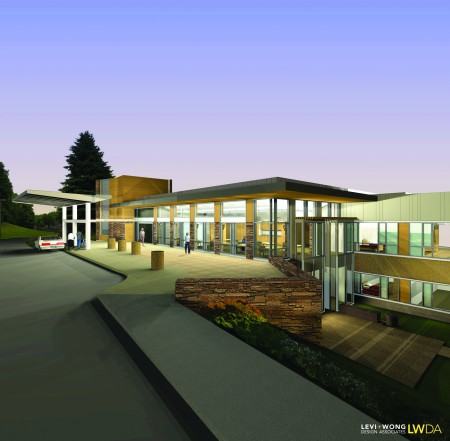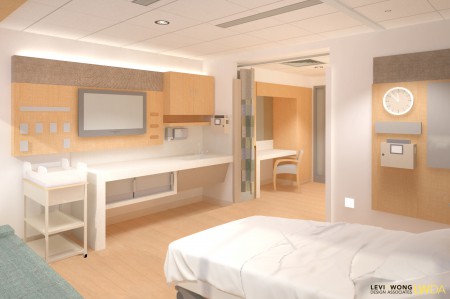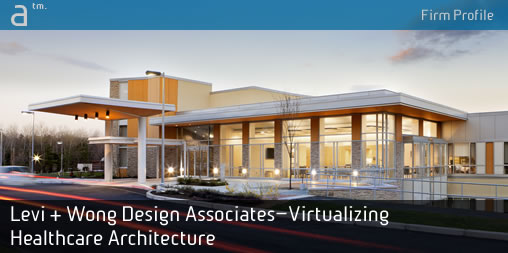Nestled within the upper reaches of an old timber-frame structure, Levi + Wong Design Associates paints a stark contrast to the ethos of the quaint and historic town of Concord, Massachusetts. Here, in one of the most important early small towns in American history, we find a firm using technology that just a few years ago was heralded as the future of architectural practice. Headed by its two key principals—Thomas C. Levi and Willie W. Wong—the multi-disciplinary design firm they lead is surprising in both its size and sophistication.
The juxtaposition between old and new was further unveiled as I spent nearly two hours touring the office with Levi and his key technology lieutenants, Lawrence Passmore, IT Director, and Vincent Boutaud.
The firm—servicing clients from Massachusetts to California, Florida to the mid-Atlantic states, and naturally all of New England—offers a full range design services including expertise in both acute care and rehabilitative hospitals, senior living and senior care facilities, specialty healthcare, and campuses and buildings for both corporate and technology.
Levi + Wong’s work is also geographically diverse. They practice all over New England and clear across the country from Florida to California. As a design firm, services include: architecture, landscape architecture, interior design and planning—all integrated into one design firm. And ‘integration’ is a good word to use to describe the firm’s design process—uniquely centered around its developed 3D ‘virtual design” workflow.
When It All Began
As it turned out, Thomas Levi didn’t begin the firm he founded 25 years ago with so much technology in mind, or that he would even one day lead a firm surfing its leading-edge. Like most architecture practices older than a few decades, they made the jump from paper to digital CAD like most everyone else, plotting along for years with PowerCADD on Macs. Then in the late 90’s Levi got introduced to the 3D ‘virtual building’ concept pioneered by Hungarian software house GRAPHISOFT.
“I wanted to be a better designer,” remarks Levi, when prompted to explain why he got into virtual building technology with Graphisoft’s ArchiCAD. “I wanted to be able to continually visualize, instead of sit here and sketch and go back and forth between CAD.”

01 – D’Youville Center for Advanced Therapy. Rendered images like this are common in architectural practices globally today, but what isn’t so common is what Levi + Wong does next and throughout the process. (all images courtesy Levi + Wong Design Associates, all rights reserved.)
At the time the firm learned of ArchiCAD and the ‘virtual design’ process they had been working for Millennium Partners, one of the global leaders in upscale development and major mover in the New Urbanism. “We were doing a balance between the healthcare and corporate back then,” says Levi, “and the corporate was some of the really fun work back then and Joe Larkin of Millennium here in Boston encouraged us, saying this technology was out there, was the future and to just do it. So we did.”
Upon making the leap to move to a 3D ‘virtual building’—or what is today referred to as BIM (building information modeling)—workflow the firm did go through some initial teething issues. “Of course on the hospital side initially it was quite fussy,” remarks Levi, “but these days the healthcare work is so precise it now actually helps us tremendously.” “Today the firm has more than 15 years of experience using ArchiCAD,” Levi adds, “and all projects and teams utilize it as their primary design tool.”
Benefits In Workflow Change—BIM For Levi + Wong
As the firm advanced with ArchiCAD and a true BIM process workflow it’s clients also began to adapt along with them, but at differing rates and engagement. Healthcare as an industry is a 800 pound guerrilla. It’s understandable—the industry in the US is just a behemoth, it’s a technical and information-laden industry fraught with complexity.
Advertisement
In healthcare architecture a lot of the ‘client-to-architect’ interaction is triune and multifarious. The architect can be asked to meet multiple, layered and sometimes competing goals. “And on the medical work a lot of information is coming into the design process from the medical staff,” adds Lawrence Passmore, Assoc. AIA, “who aren’t trained in the architectural process and yet they have to understand dimensional drawings, which can be a little strange for them sometimes. And so,” he continues, “when I started here Tom was really interested in having us model all those little details, medical equipment, and showing them to the medical staff to get their feedback on them.” (see images 02, 04.1 – 04.2)
“We model everything,” says Levi, “if we can’t buy it we can model it up quickly.” “Yes, the model is a type of diagram” adds Boutaud, “it doesn’t have to be perfect or an exact replica of a given device, but it communicates the story.” To facilitate this, Craig Boyer, a former Graphisoft technical representative, works as a BIM facilitator, building smart objects on demand and managing consistency in the process, and Keith Bradly works as a visualization coordinator, assisting design teams with CINEMA 4D to transition their models into photo-realistic images and movies.
The firm has built-up a growing 3D model library with hundreds of 3D accurate models of medical and healthcare equipment found in every type of exam room, triage unit or OR suite. This is benefiting the firm as times goes on.

02 – A postpartum room, looking at the foot wall. This image is from ArchiCAD model rendered in Maxon’s CINEMA 4D.
Levi notes that the ‘virtual design’ and BIM workflow does force decision-making earlier in the process. He indicated that when they are in the traditional schematic phase they are actually mid-way through design development. And when they are mid-way through design development they are substantially into construction documents. “It is really front-loaded decision making and it does speed the process up.”
next page: Industry Under Pressure—BIM for the Healthcare Industry




Reader Comments
excellent article by @architosh on #ArchiCAD firm, Levi Wong Design Associates http://t.co/JVCuXOuZFt
RT @BIModel1: Firm Profile: Levi + Wong Design Associates—Virtualizing Healthcare Architecture http://t.co/bILb6hTNob via @architosh
Firm Profile: Levi + Wong Design Associates—Virtualizing Healthcare Architecture http://t.co/b6BUTcvOVd via @architosh
RT @ArchiCAD: RT @BIModel1: Firm Profile: Levi + Wong Design Associates—Virtualizing Healthcare Architecture http://t.co/bILb6hTNob via @ar…
RT @BIModel1: Firm Profile: Levi + Wong Design Associates—Virtualizing Healthcare Architecture http://t.co/Xw1lcOndG1 via @architosh
RT @ArchiCADGirl: excellent article by @architosh on #ArchiCAD firm, Levi Wong Design Associates http://t.co/MU5k6V8l94
Maik Obermüller liked this on Facebook.
RT @ArchiCADGirl: excellent article by @architosh on #ArchiCAD firm, Levi Wong Design Associates http://t.co/BzS9qALUvZ
RT @BIModel1: Firm Profile: Levi + Wong Design Associates—Virtualizing Healthcare Architecture http://t.co/Xw1lcOndG1 via @architosh
Maik Obermüller liked this on Facebook.
Greg Conyngham liked this on Facebook.
Greg Conyngham liked this on Facebook.
Firm Profile: Levi + Wong Design Associates—Virtualizing Healthcare Architecture http://t.co/hqMAf0iFF4 via @architosh @bimodel1
Firm Profile: Levi + Wong Design Associates—Virtualizing Healthcare Architecture http://t.co/hqMAf0iFF4 via @architosh @bimodel1
[…] Read on… […]
Comments are closed.